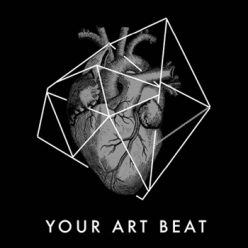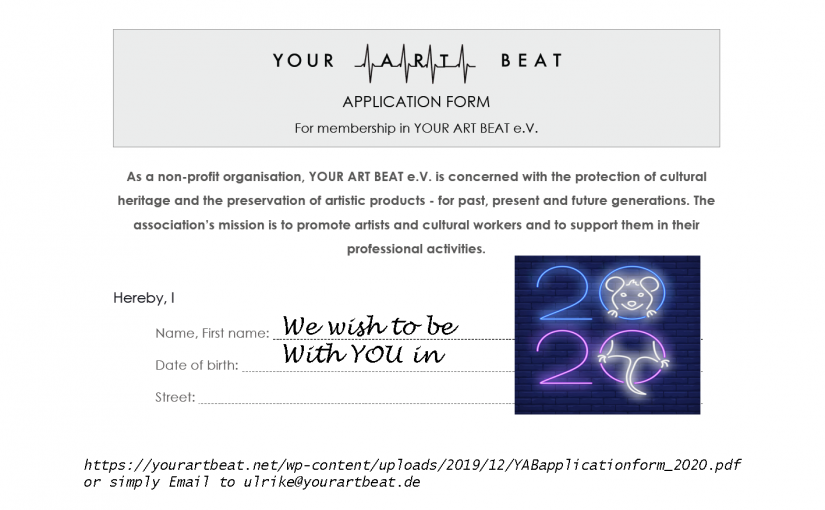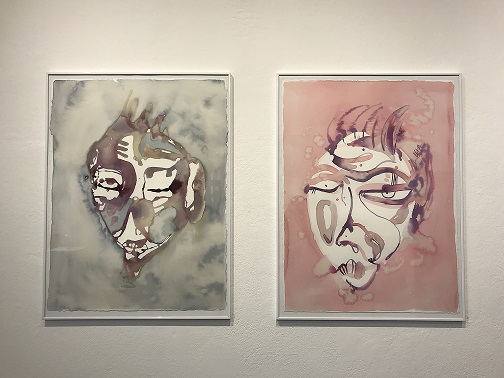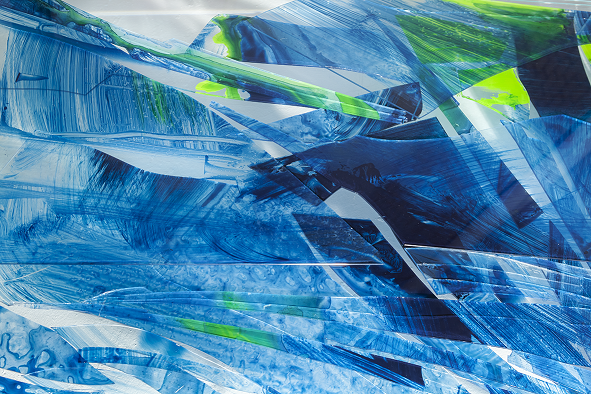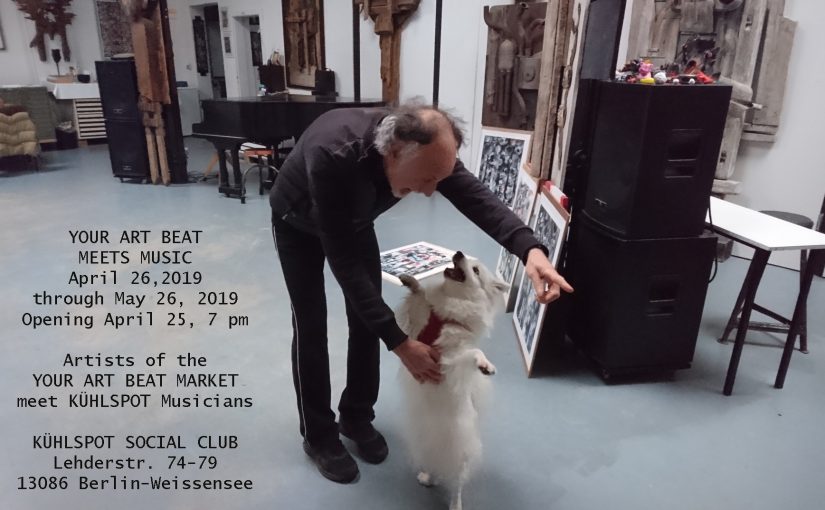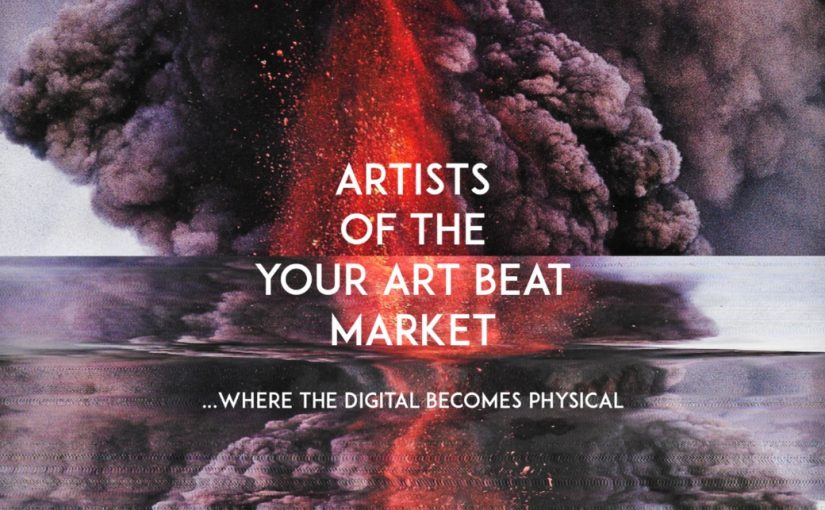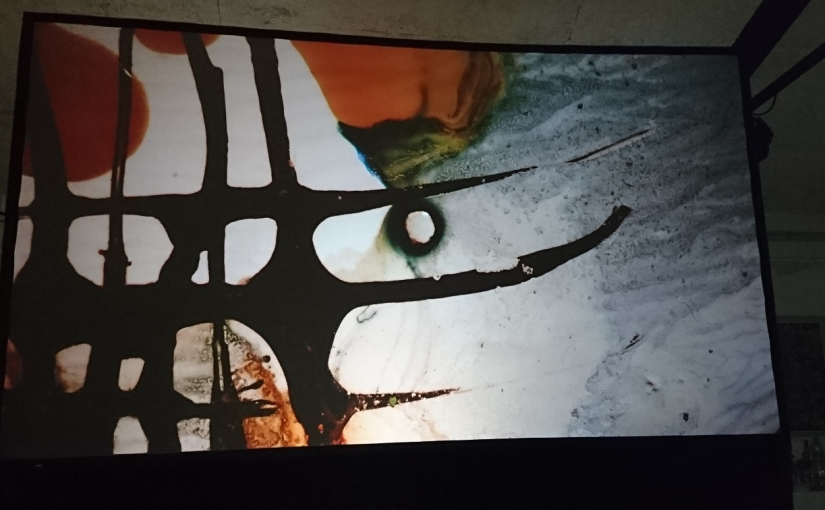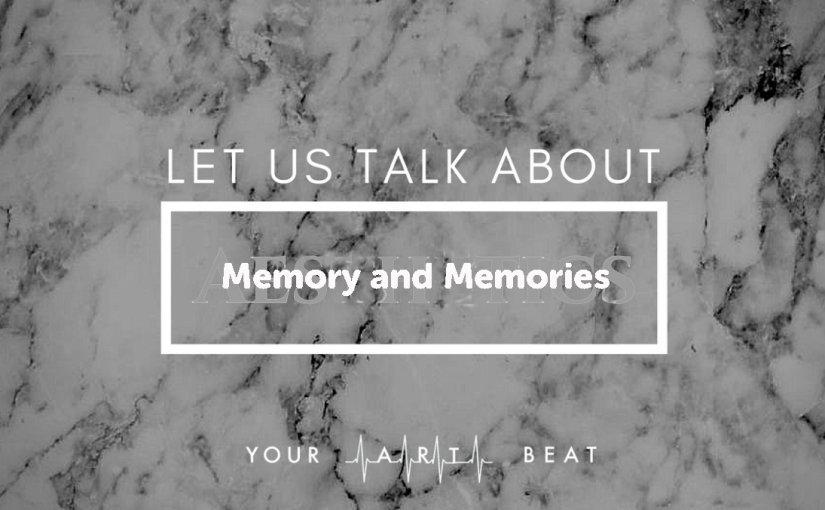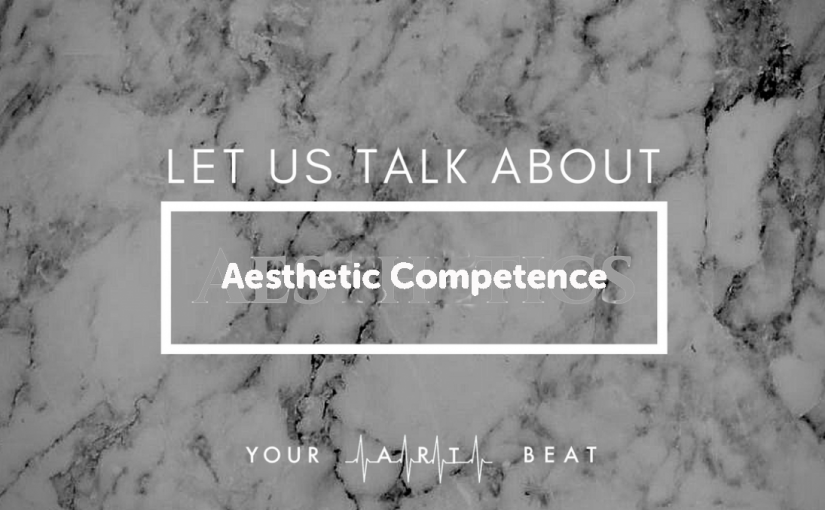http://yourartbeat.org/wp-content/uploads/2019/12/YABapplicationform_2020.pdf
Author: Ulrike Wiedensohler
Exhibition Introspective in Perspective
Lita Poliakova
Introspective in Perspective
WerkStadt Kulturverein Berlin e.V.
May 5 through June 9, 2019
Lita Poliakova’s portraits exceed all expectations regarding the genre. Each single work turns both inwards and outwards. We are able to recognize the sketch of a face looking at us like an expressive character in a science-fiction comic. At the same time it seems to turn its interior soul toward the outside at each point of its shaping and color rendering: Like some kind of psychogram which merges associations of different moods and expressions.

On another level, the exhibition is constantly blending humans and nature like some sort of hologram. It is an astonishing and fundamental common ground that comes into view: the elements that all organisms are composed of and dissolve into. These elements are the same in humans and plants. The artist makes use of these micro-components in her splendid organic recycling: She extracts color pigments from organic materials, such as left-over fruits, and applies them to her paintings. There might be unpredictable further variations of these organic colors. Finally, it is the solid, yet expanding crystal structure that could be understood as an anorganic and dynamic complement of the paintings.
Thus, between screen and crystal, the colors continue the play of depiction on a material level.
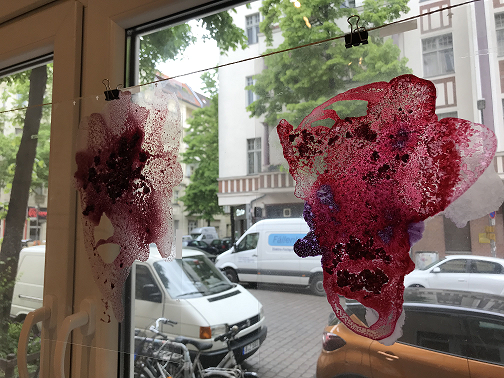
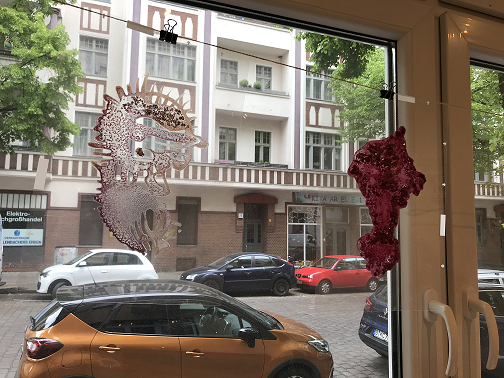
Is this a human face, whose sense of self, affections, facets and transformations shows up in the emergence of colors? Or is it a landscape or even a singular plant that can be depicted as a human with the help of our gaze? Do we identify the ongoing metamorphosis of a single individual or rather a huge family album or chemistry of humans, flora, and fauna?
Jule Böttner
WerkStadt Kulturverein Berlin e.V.
The Cut In
»The Cut In« is a duo project formed by an artist, Saverio Tonoli, and a designer, Nona Schmidt, from Berlin.
Between Art and Design – collage is a common topic between the work of the two of them. They paint, cut and compose their images using analogue and digital techniques as part of their creative procedures.

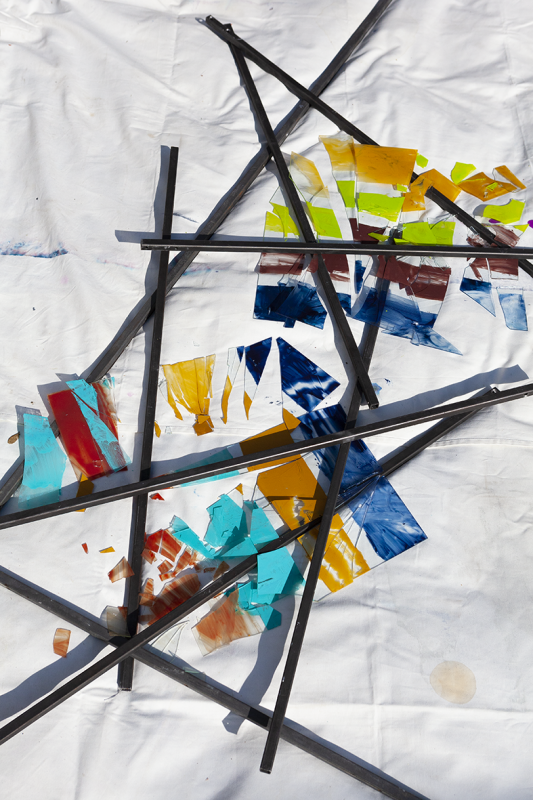
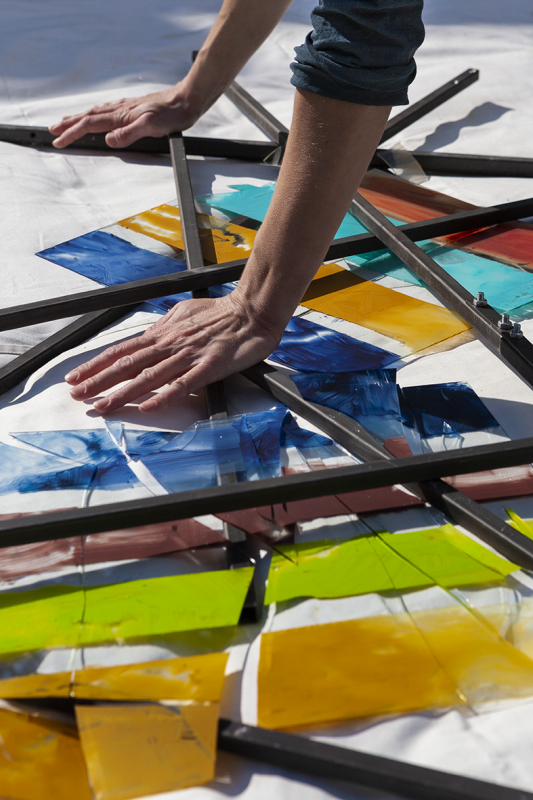
This project investigates glass and its possibilities, not only as a material but as a medium to explore colours, forms and structures.

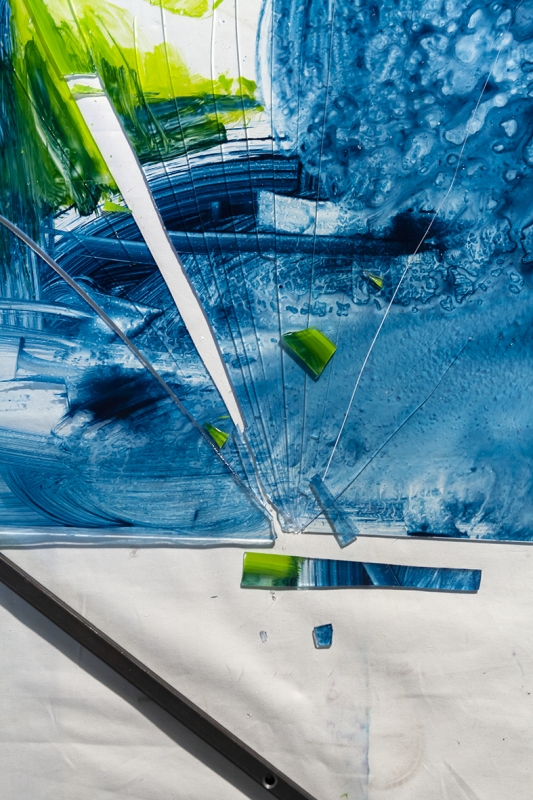
»Cut In« reinterprets traditional leaded windows and their immersive quality by juxtaposing different layers of coloured glass and integrating the glass collages in the architecture.
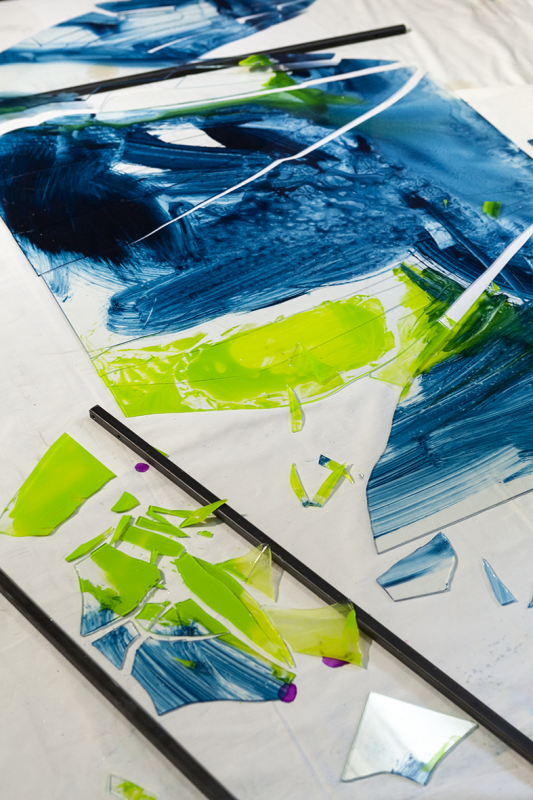
»Cut In« are in fact thought to be installed in the space, where transparent and coloured glass shapes blends, overlap and transform themselves under the intervention of light.
A starting point of the project has been the exploration of colours, discovering combinations of harmonic and disharmonic colours in relation with Runge’s theory of colours.
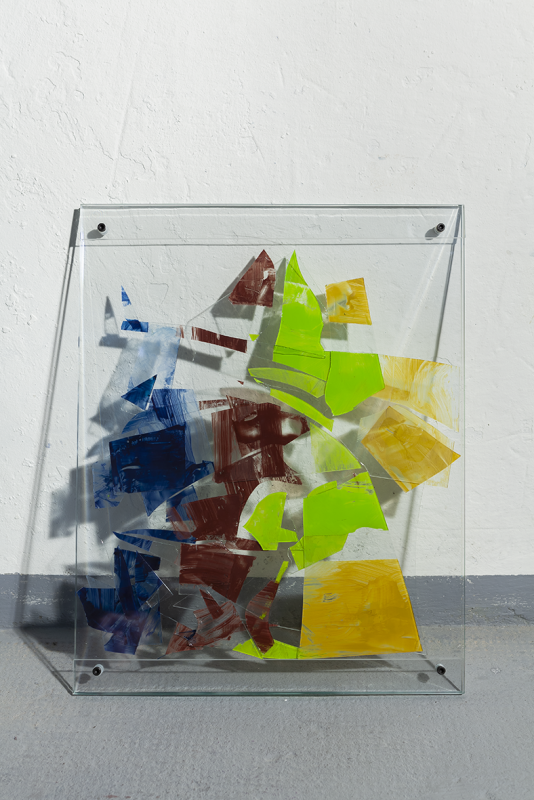
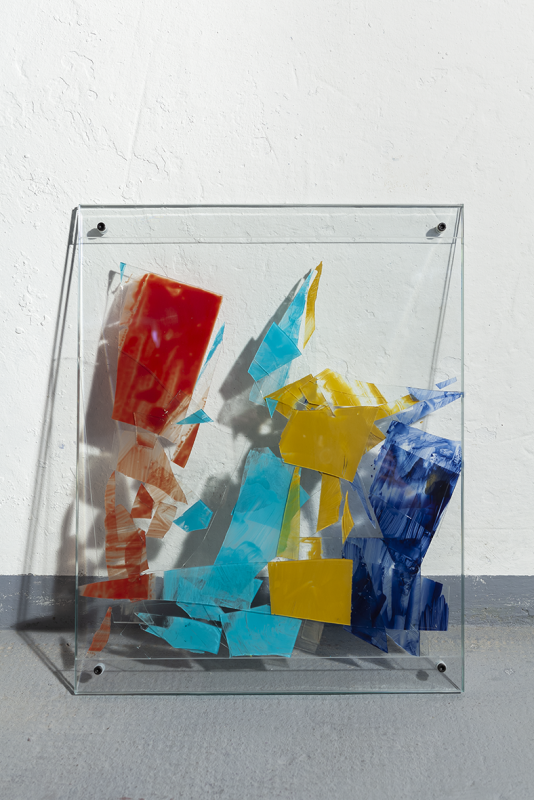
The collages are made out of one painted image on glass. Through different breaking techniques which they call the »Bruchtest«, the painted image is exposed to an unknown factor creating new situations to work with and finally arranged and repainted into one single piece.
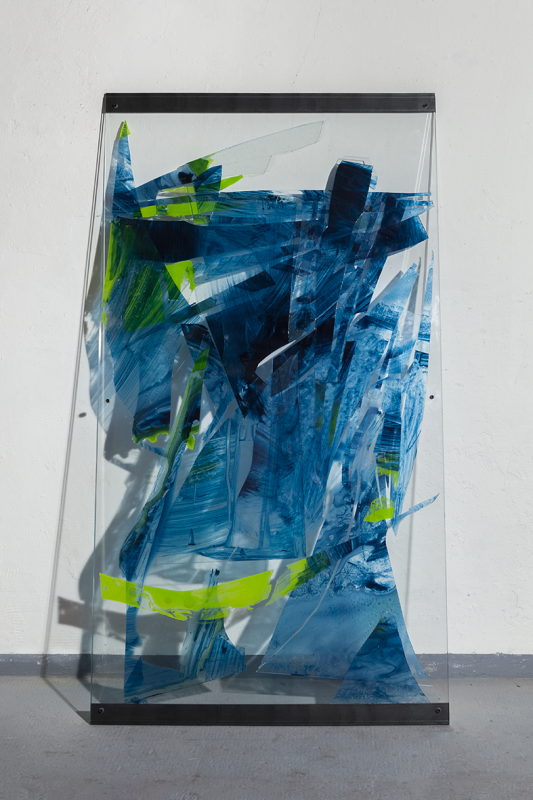
YOUR ART BEAT MEETS MUSIC
Kühlspot Social Club is a venue for creative music, theatre, art and culture in Berlin Weissensee. They emphasize “social” in their perspective on cultural development and try to promote an inspiring community of artists and art lovers. In the field of music, the main focus is on improvised music, jazz, dance music of all kinds, including improvised dance music, tango, balfolk, and everything always live. In the course of the season – there is a break in late summer and in winter – they have one to three events per week, two to four art exhibitions per year and occasional dance parties. Performance art, theatre events, and action painting with improvised music are also part of the spectrum of the program. The room can accommodate up to 70 people.
Kühlspot is the former studio of the Berlin artist Siegfried Kühl, who died in 2016. His son, the artist Christoph Kühl, runs the Kühlspot. The art of Siegfried Kühl is permanently exhibited and contributes essentially to the great ambiance.
For more information see www.kuehlspot.com/kalender.html
YOUR ART BEAT is happy to be part of the Kühlspot community and exhibit some of its artists, among them Christoph Kühl.
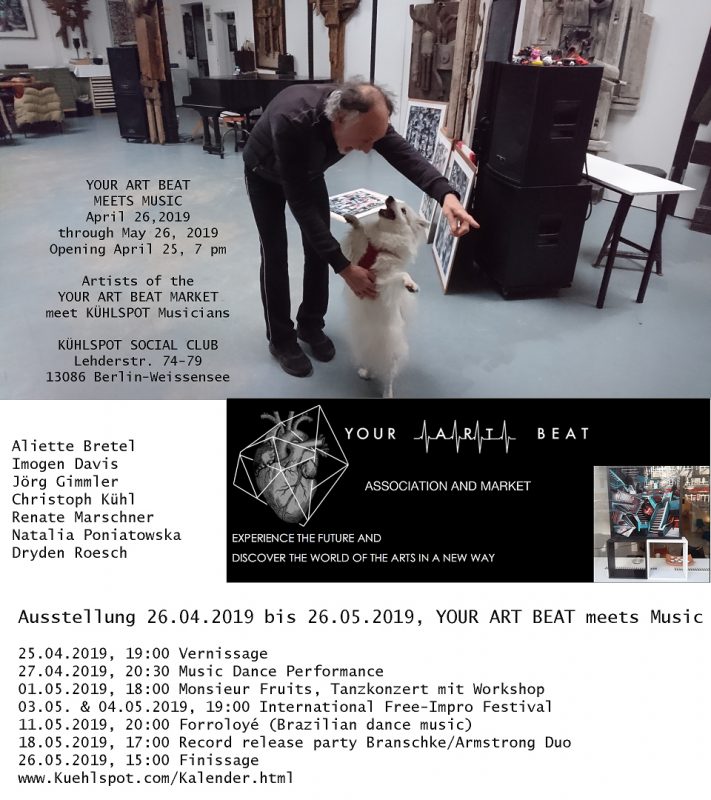
Group exhibition of YOUR ART BEAT artists
Where the digital becomes physical: Galerie Salon Halit Art in Berlin-Kreuzberg presented artists of YOUR ART BEAT, February 14 through 28, 2019
The group exhibition displayed a selection of artworks of some of YOUR ART BEAT’s unique and versatile international artists. For the prints, different materials were used such as glass and aluminium, but also FineArt Paper.
The visual artist Lita Poliakova (Life Is Torturing Awesome) portrays mental and physical transfiguration and recycles paper agents in order to catalyse the novelty. Her digital collages were printed on glass. She also presented a video on the creation of her work. 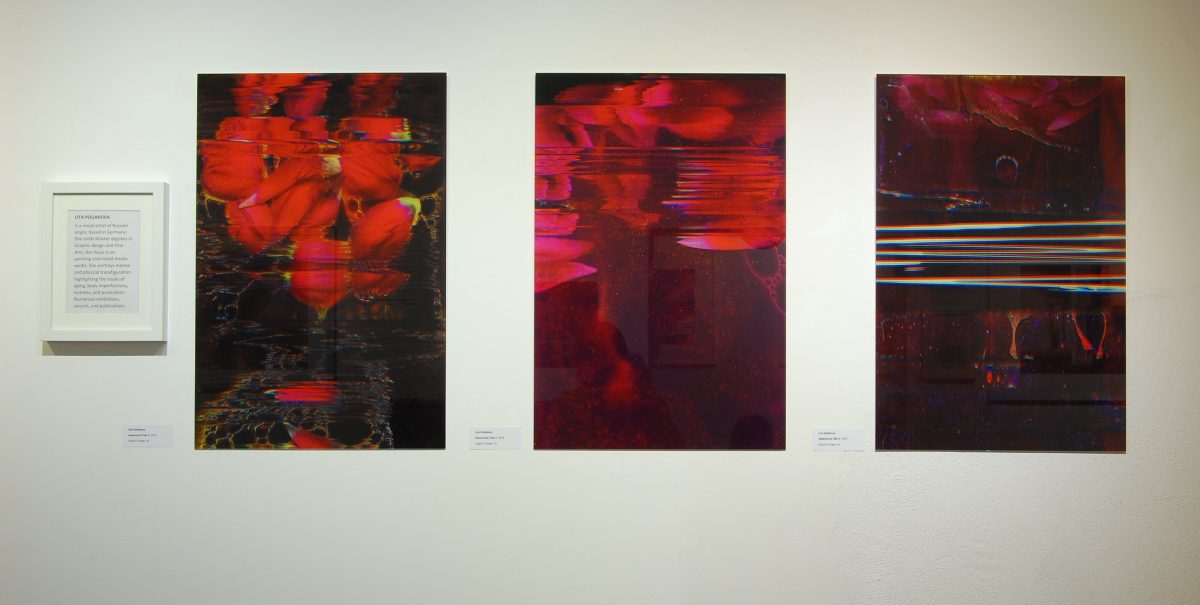
Dryden Roesch is an artist and graphic designer from Edmonton, Canada. Most of his recent work depicts architectural environments in vibrant and surreal ways to create an imagined (and sometimes disorienting) sense of place. 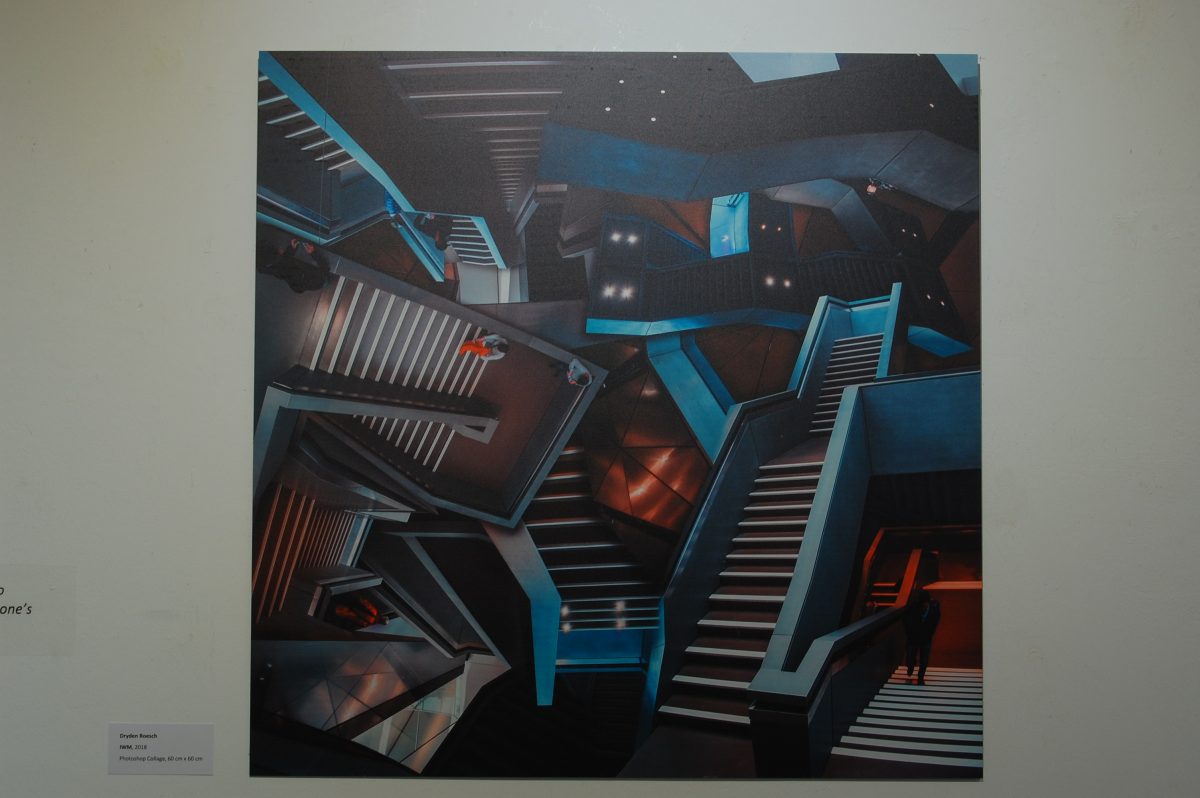
Sonia Bensouda is exploring the notions of time and space. She is an Interior Architect and Collage artist. Through digital collage and photography, she intends to explore the notions of Time and Space in the Urban environment. Her digital collages with old photography are printed on FineArt Paper. 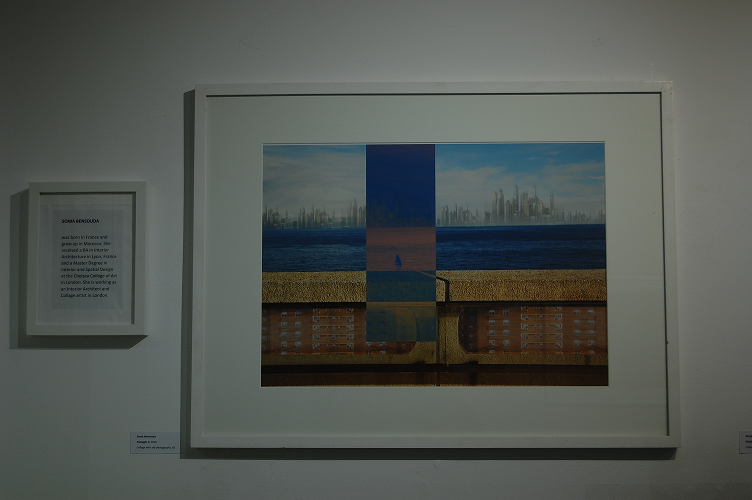
Natalia Poniatowska is swinging between the digital and analogue photography, still and moving image. Project White is her investigation into the notion of absence of colour. She wanted to investigate what happens when we take out the colour of food. She painted the fruits white and they became completely new objects that are no longer associated with food and taste. She wants to make others notice how beautiful our senses are. 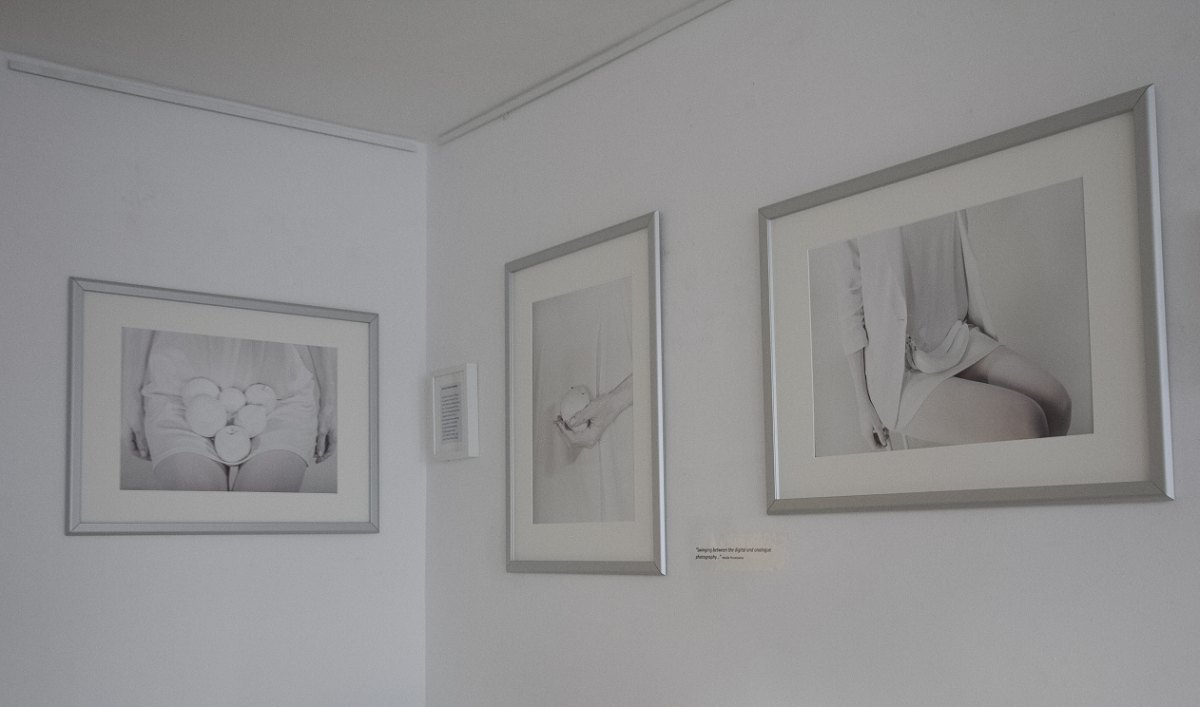
The London-based photographer Imogen Davis believes that photography is used to capture moments of peoples’ lives, moments that would otherwise be lost in our memories forever. For MY BREATH she learnt how to blow her own glass, making physical recreations of her breath that now have memories of their own. The MY BREATH series I-X was printed on glass. 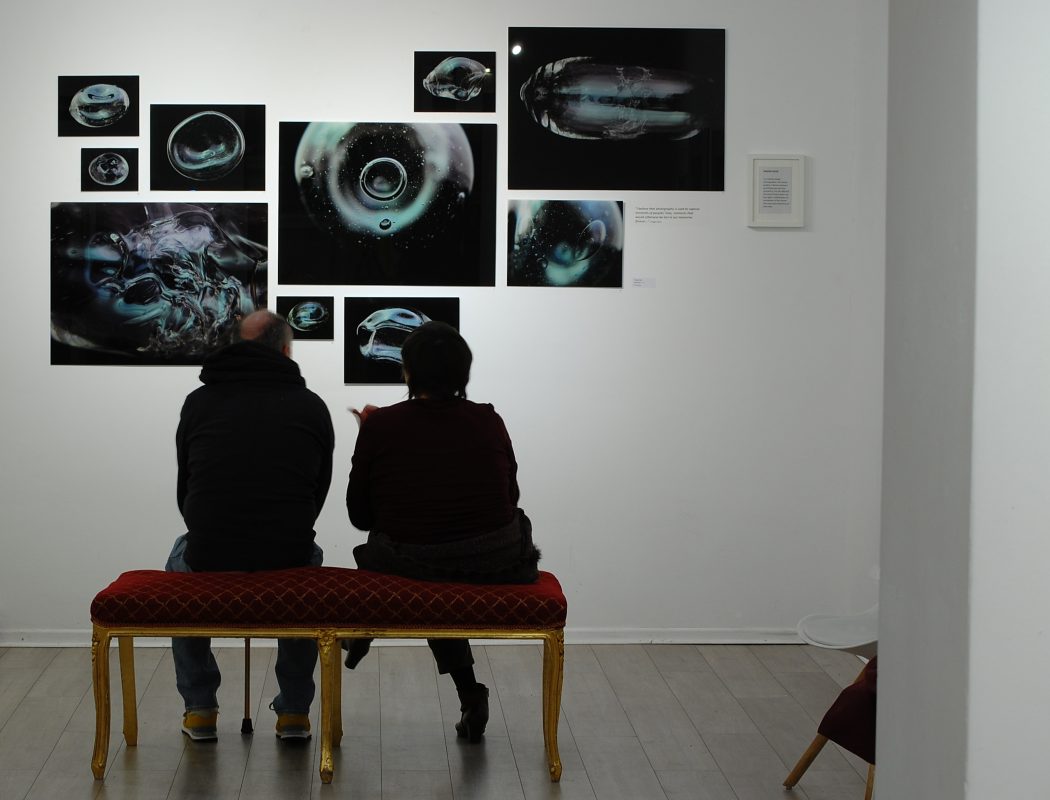
Christoph Kühl’s works are almost exclusively collages, i.e. they are made of painted paper by using various techniques. The viewer is taken on a journey through three-dimensional spaces. Christoph’s collages are the projection surface of these sensational sites. Found image pieces are put together to convey new impressions.
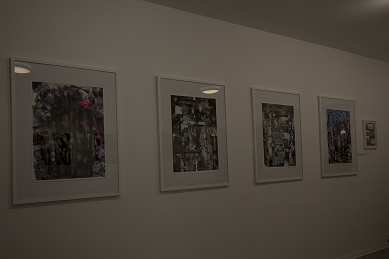
Renate Marschner (1953-1990) was an artist from Lower Saxony and worked as a painter and broadcasting author in Berlin, Karlsruhe, and Switzerland. She has displayed her works in Berlin, Heidelberg, and New York. Her works deal with the issue of getting used to understanding things we don’t see. 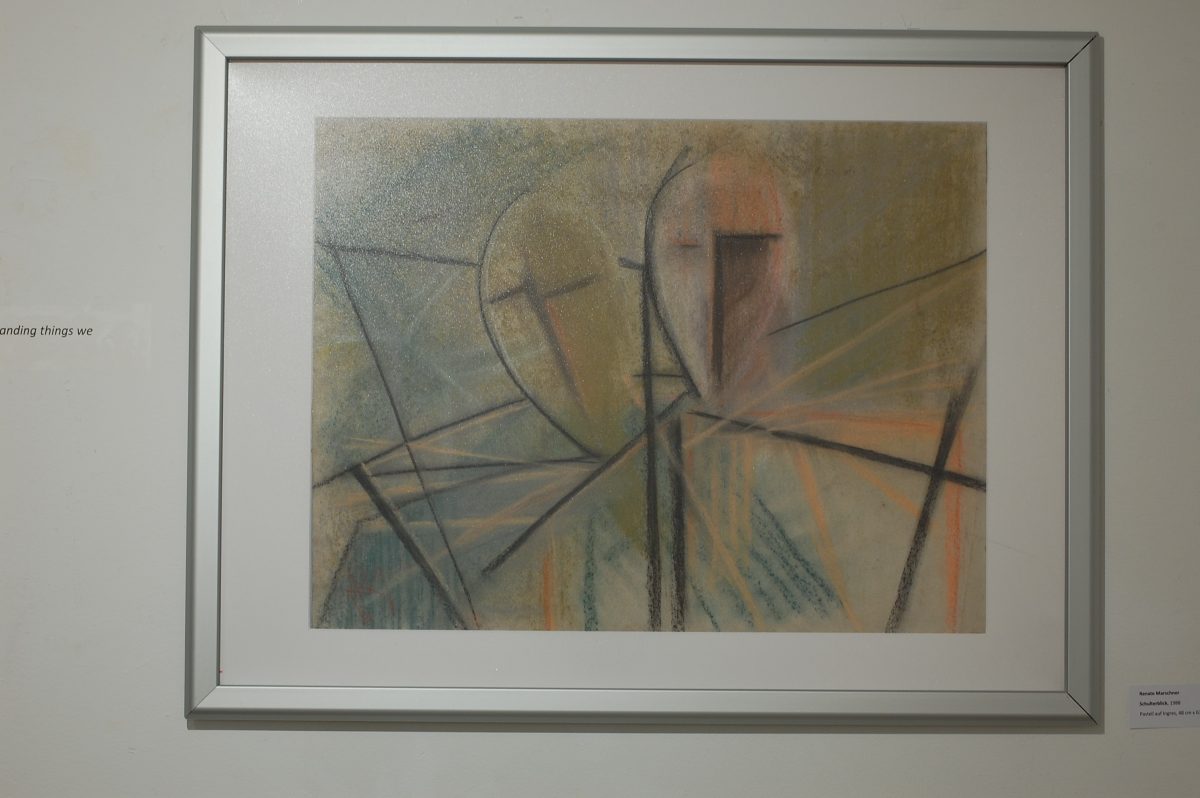
For Zsolt Gyarmati, Art is Confrontation. The objective of his art is some sort of status report. Art should make people conscious of unconscious things. He showed the video DIOXINDAUER in Berlin.
Selma Köran (video) and Jonathan Rosenberg (music) have created an audiovisual dialogue with Renate Marschner that was shown for the first time. It is based on Renate Marschner’s drawing SPERRUNG (BLOCKING), oil chalk on school board lacquer. Selma Köran made a stop motion film with knead and Jonathan set it to music. 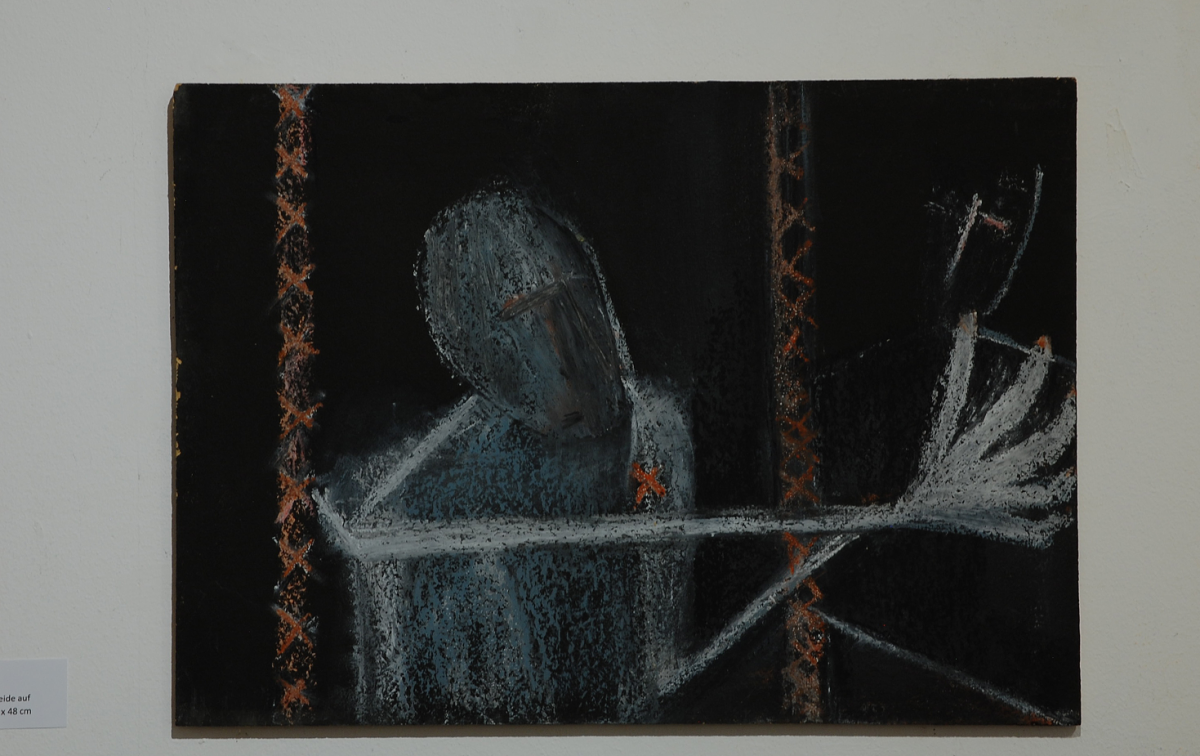
Lita, Dryden, and Christoph attended the opening of the exhibition. Thank you for this.
Audiovisual Ventures
Akiko Nakayama is a Japanese painter. She felt that her past paintings were dead, so she started Alive Painting by combining the energy of movement and the vibrance of colours. She uses a multitude of kitchen basters loaded with paint and water to add, mix, tilt, blow and add all sorts of extraneous effects to her paints, recording and projecting it all onto a large screen. The result is a fascinating show of organic movements. In recent years, she has also added sound as another dimension to her work, and has collaborated with different musicians in live performances.
On November 4, 2018 she performed at THE KÜHLSPOT SOCIAL CLUB with Uproot, an electroacoustic music group (curator Kriton Beyer). The trio works with the use of both the natural sounds of the acoustic instruments as well as with preparation of these instruments, the use of objects and extended techniques.
It is always inspiring to visit the KÜHLSPOT SOCIAL CLUB. The ambience is very private, and performers and audience get in touch and discuss music, and art and life.
Memory and memories
The pleasant experience or its opposite are the backbone of our memory, the connection of our episodic memory with our semantic memory.
Do I remember my first visit to a museum? It was in New York City in 1976, at the Museum of Modern Art. What do I remember? The impressive collection of modern and contemporary art in a fantastic building with a beautiful sculpture garden. 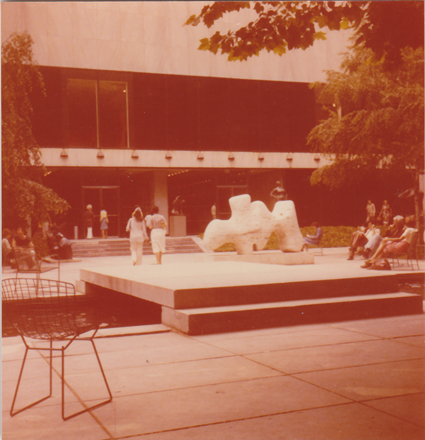
A painting by Mark Rothko, Magenta, Black, Green on Orange, painted in 1949. The painting shows his strict attention to detail, composition, depth, balance, color, and scale.
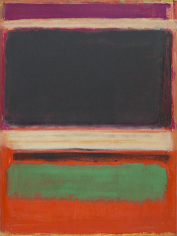
However, was I there or did I internalize stories of a friend who told me about his visit to the museum that made me think I was there myself?
How does the memory actually work?
Roughly, there are three sections of memory: perception memory, short-term memory and long-term memory. All information is initially stored in the perception memory and at the same time, the brain decides what to assign to the short-term memory and what to ignore. People are actually not able to store or process everything. They need to distinguish. The short-term memory is the working memory where all information is processed. Here, information remains for less than a minute. When people get older, their short-term memory becomes more susceptible. Short-term memory determines which information is fed into long-term memory. Whether the pieces of information are actually embedded there and retraceable depends on the codes they have been provided with. The long-term memory is dependent on information being sufficiently coded, either by adherent emotions or by special learning techniques. Nothing is lost from the long-term memory; forgetting is just a failure to retrieve content from memory. Therefore, stored data must be searched for, since it is usually not immediately available.
However, commemoration can be tricky. Because when we remember, we form fragments that we have experienced at different times and places into recollection or something that feels like recollection. Moreover, every time we remember something, when we dig out memory content, we modify it again. By the mood we’re in right then, by new information we didn’t have then. This is like a file that is modified repeatedly, and only the latest version is available. Therefore, we may have false memories, or there may be details in it that are not right. The memory is flexible and cannot objectively reflect the past, but adapts to the present identity of a contemporary witness.
So it becomes clear that a strong distinction has to be made between personal memories and reality, since our remembrance may be pure fiction, fantasy and perhaps a dream.
“In Search of Lost Time” is a novel about time, about forgetting and remembering.
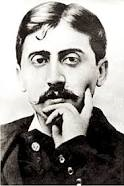
How can one escape the incessant elapsing of time? Proust’s answer: Only by remembering the panorama of the past in special moments, for example by enjoying the famous Madeleine or the scent of lilac. These are moments of sheer beauty, great sensuality and pure happiness.
Back to the Museum of Modern Art in New York City. Rothko’s painting has burned itself into my memory as an image; in fact, I did see it there.
Faces. Places
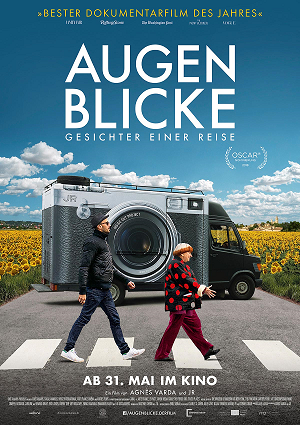
An unusual couple: Agnès Varda who just turned 90, a filmmaker and star in France since the 1950s. And JR, the street art and photo artist, who never takes off his sunglasses.
When they meet, they decide to do something together. What exactly, they don’t know, “a new kind of images” is the rough idea. Together they go on a journey cross-country with no clear aim and destination.
The only clear thing is: It had to be a real documentary. A film about other people. It seemed clear that his passion for sticking huge portraits of people to walls to honor them, and her way of listening to them and bringing their stories to the fore, would lead to something.
JR’s truck plays a leading role in the film: a mobile instant photo machine that transforms photos into huge black and white posters. They drive through the villages. Most people approached by JR like to be photographed. These encounters give rise to the wonderful documentary: “Faces. Places.
Agnès Varda is looking for people who once dug for coal in the mines and descendants of those miners. Jeannine is the widow of a miner and to be resettled, but she wants to stay: “I will not be driven out. I have too many memories here.”
JR and his people transform the whole settlement into a kind of stage, with old photos, in memory of the miners of that time. Jeannine also appears on the façade. She’s speechless. 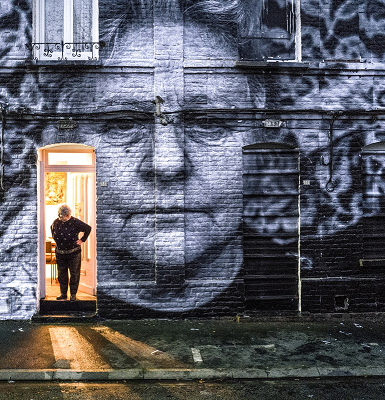
Some lose their composure when they see themselves in JR’s pictures. The small, inconspicuous life suddenly becomes visible and significant – also for them. “Every story becomes a work of art. I mean not only stories between Jeannine, and us but also between Jeannine and the viewers. The audience should love those portrayed. That was the plan. Jeannine as well as the postman, who was very proud of his giant photo! By enlarging the portraits, we make small moments big in the lives of people who are not in the spotlight,” says street artist JR. “Everyone in the village knows them, but all of a sudden you look at them with different eyes. They are talking about their picture. That is what the movie is about. That’s what art is about.”
Agnès Varda and JR stop where no tourist will ever get lost. They just follow the road, trust chance. Then stop in the right place – this is art, too. In a remote chemical factory, they get the entire staff to pose for a group photo. The people from the day and night shifts have little to do with each other – in the photo they are united. An employee can hardly believe it: Employees from all departments and shifts are mixed. You can also see some from the executive level. “So we do get along sometimes!”
JR and Agnès Varda’s film is not just about the charm of inconspicuous places and ordinary people. It is the story of a touching relationship between two artists who are separated by an age difference of half a century and yet find a common language.
The film also deals with this: time that can only be captured for moments. Moments that cannot be big enough because they are over so quickly.
Aesthetic competence
Aesthetic competence by Matthias Welker, Berlin.
Why do I write a post for the YOURARTBEAT blog? What motivates me to share audiovisual experiences in the social media? What do I get from other people’s participation in my experiences? Do I want to seduce the readers/viewers/listeners to their own sensual perception of something new or forgotten? Do I want to tempt others to follow my value judgments and convince them of my aesthetic competence? Anyway, what is aesthetic competence?
Human beings are well equipped by nature with sensual perceptions, not only to control adaptation and integration, but also to stimulate the reward centre. Our brain mixes cognitive, episodic and social experience with sensory impressions to create feelings of happiness.
Taking a memory as an example: the beginning of spring, sitting with my lover at Lake Constance, outside in the warmth on a wooden bench, with two glasses of Dole du Valais. However, why do I remember the warmth, the light, the smell of wood, the taste of wine and the view of Lake Constance so clearly after decades? The feeling of happiness had a name: ESCAPED!
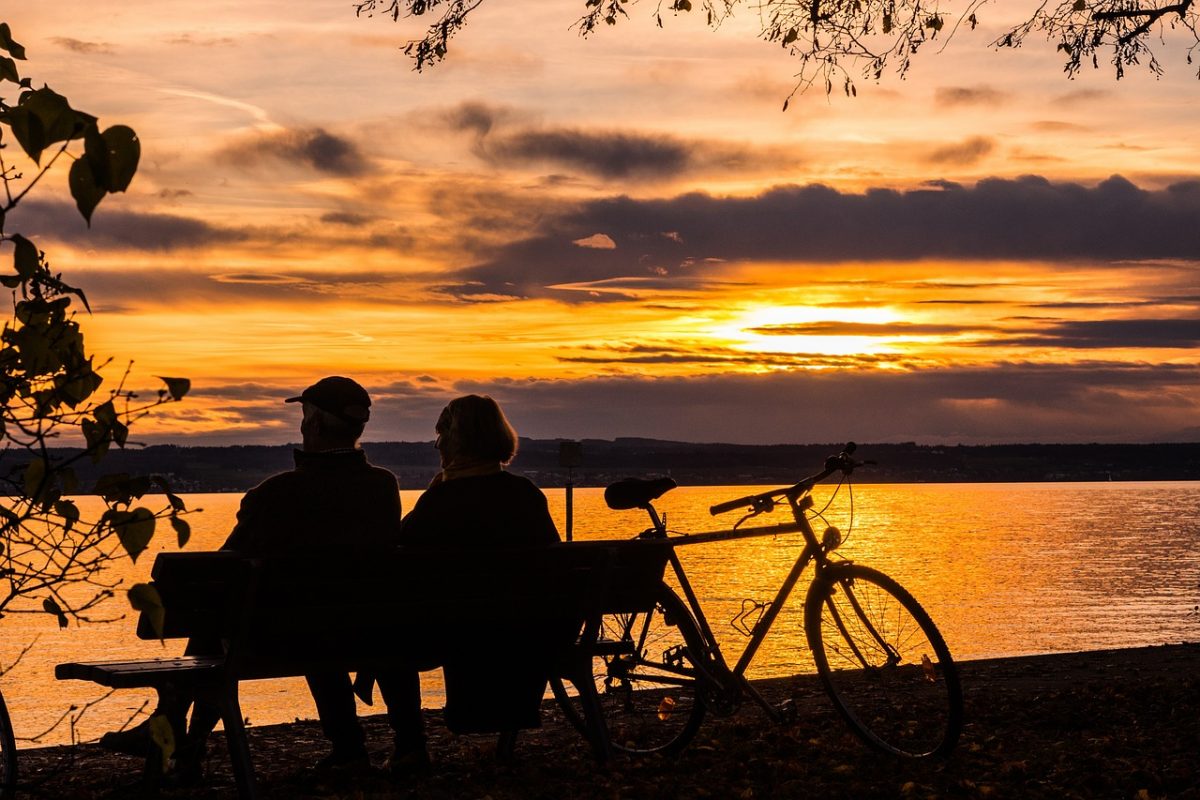
I came from a disastrous financial situation, but then a brave Swiss driver crashed into the chassis of my old Opel. The cheque by the Swiss National Insurance had just converted into life and experience.
Okay, sex also supports our survival, but it is not really remembered intensely sometimes for this biological purpose or rather forgotten in spite of the purpose. However, what about the buzz? Buzz can be dangerous and only sometimes procreates children. Is aesthetic experience a kind of intoxication without a hangover in the morning?
Aesthetics deals with artefacts, material or immaterial creations of human beings and with the interaction of humans with these artefacts. If it comes to lasting impressions, something like a chronofossil is created; at least for a short period, the artefact shapes the experience and memory of social processes. This is not possible without the aesthetic competence of the recipients.
Everyone has aesthetic competence. At least in the habit and distraction. The philosopher and cultural critic Walter Benjamin argued, based on architecture, that people have always vitalized artefacts by inspection and sensual experience. Unfortunately, Benjamin was interpreted as elitist in the last century. However, for Benjamin, habituation and distraction had nothing to do with disrespect. Projects such as his “Passagenwerk” are not really understandable without this approach. Benjamin says that artistic creation must face the changes in human reception. The panel is an artistic format of the Middle Ages; if this no longer works in the 21st century, artistic design processes must either revive it or develop new formats, e. g. socially interactive formats of artefacts.
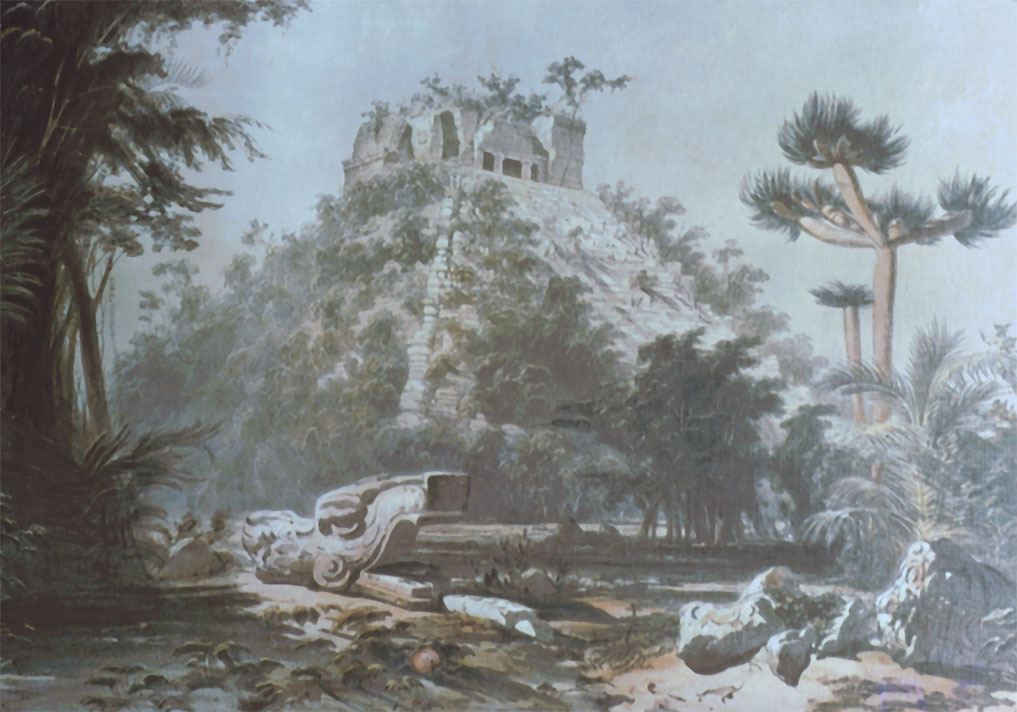
Without attachment to the public, artefacts will perish. The Mayan pyramids were important artefacts. The Mayans were used to inspecting these artefacts by walking around. Without the inspection of the accustomed and distracted Indians, these artefacts were lost and have to be brought back into human memory by archaeologists. However, this is not the same experience.
An example of the present is the Berlin TV tower. I find the building extremely ugly. The whole Alexanderplatz, which used to be called Ochsenplatz (Ox Square). I still call it Ochsenplatz and the TV tower Ochsenturm (ox tower). However, I am used to the Ox Tower as an icon of promise.
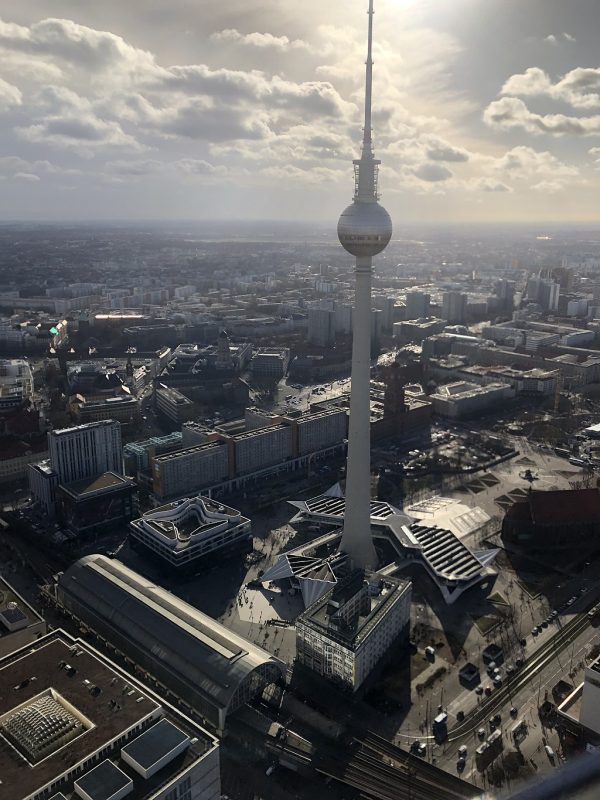
No matter whether by plane, train or car; when I approach the silhouette of Berlin, it says to me: You are now back in Berlin, one of the few cities in the world where Mief is an annoying marginal, but the creative and productive restlessness has a big nest. Bad pay, no big apple. But how Leonard Cohen sang: First, we take Manhattan, then we take Berlin.
Okay, I teach at a university, which resides in one of the remaining buildings of Hitler’s Germania. Due to monument preservation, my office has a brown linoleum floor, but still better than an office in the Trump Tower in New York.
So much for the one component of aesthetic competence, aesthetic emotion. Models of aesthetic experience reflect the parallel cognitive and social components for the emergence of aesthetic judgment. The evaluation of sensory impressions is compared with previous experience; pattern and content recognition are conceived as conscious reception with individual and social interpretation schemes and merged with affection, the aesthetic emotion, to form a judgment. This judgment can be communicated and undergoes changes.
Through social contacts, people have always been enabled to inspect, see, hear or feel artefacts, attend their event or select them through reading.
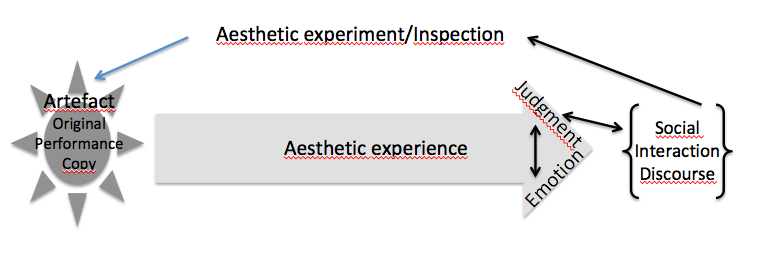
In spite of this social feedback, the direction in the pre-digital past was given, the sensual experience of artefacts almost always took place before the aesthetic judgment. Canonical education and socio-cultural Meta texts, filtered by journalistic institutions and art critique, formed the aesthetic power of judgment.
Canonical education, reading literacy, and aesthetic experience training are increasingly based less on educational institutions. The primary source of information about innovations and stored information about artefacts is the Internet. The problem: What we don’t search in the Internet is not to be found. Sensual experience is increasingly taking place after human-computer interaction, the confirmation of one’s own digital identity. The judgment is before contact with the artefact with all contingent problems.

Cultural Meta texts are replaced by discourses in the digital communication space. However, these discourses have to be conducted.
The YOURARTBEAT blog calls for sensual experience before aesthetic judgement. It trains aesthetic competence in one’s own description of experiences and the explanation of judgements. It provides new opportunities of the network to participate in aesthetic discourse, and the creation of permanent interactive artefacts. Participants of YOURARTBEAT create Meta Art.
Streifen auf der Fensterscheibe
Streifen auf der Fensterscheibe, Contribution by Yvonne Michalik, Berlin
Akribisch zugeschnittene dünne Streifen, die sich zu einem Muster anordnen, überall sehe ich sie seit Neuestem in Berlin Mitte. Meistens sind sie an Fensterscheiben von nicht vermieteten Länden angebracht. Beim näheren Hinsehen zeigt sich, dass der oder die Künstlerin hier wohl lange und sehr überlegt gearbeitet hat. Jeder Strich ist präzise angebracht und genau fixiert. Das Ganze ergibt ein Muster von durchdachter Achtsamkeit. Zeit und Muse müssen hier drinstecken. Dem rhythmisch hektischen Leben in Berlin gibt diese Kunst eine neue Note. Still und fein ist sie, überraschend einfach und doch kompliziert, überall aufzufinden. Doch vor allem zeichnet sie sich durch eine eigene Handschrift aus.
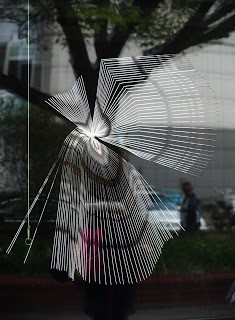
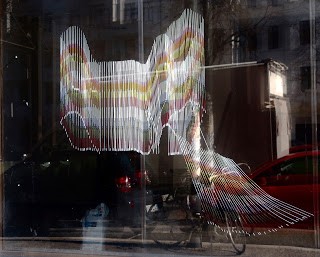
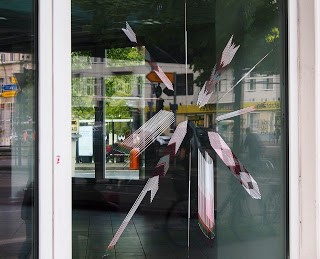
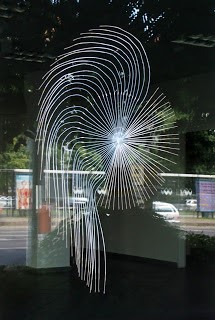
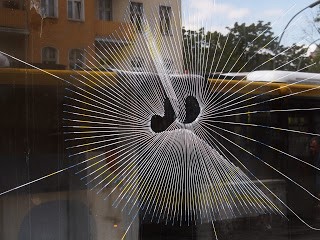
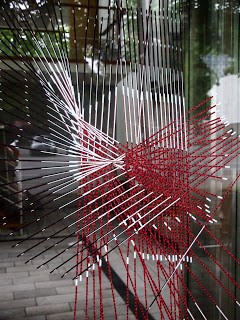
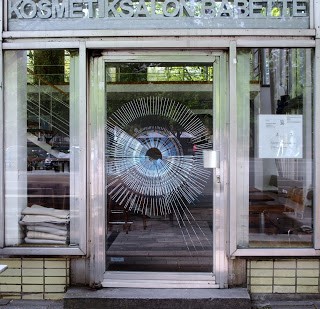
Wer ist die oder der Künstler, der/die sich so viel Mühe macht und davon ausgeht, dass spätestens bei Vermietung oder Abriss ihr Kunstwerk erlischt? Keine Signatur, nichts. Erst beim Babette, einer vermieteten Kneipe an der Karl-Marx-Allee, sehe ich dieselbe Handschrift. Diesmal steht auch ein Name: Birgit Hölmer.
Ein kurzes Interview mit der Künstlerin:
Können Sie über sich und Ihre Kunstausbildung etwas einleitend sagen. Welche Kunstausbildung haben Sie und gibt es vorher Werke, die zu der Idee der Cuts führten?
Ich habe Visuelle Kommunikation an der Fachhochschule Münster von 1990 bis 1995 und 1995 bis 2000 freie Kunst an der Kunstakademie Münster bei dem Konzeptkünstler Timm Ulrichs studiert. Seit 2002 lebe ich in Berlin. Es gab schon ähnliche Arbeiten mit Strukturen, z.B. Meine Utopischen Objekte von 2003. Dabei presse ich Tonkugeln durch gemusterte Gardinenstoffe. Es entsteht eine plastische Version der Gardine. Wenn die Tonobjekte gebrannt werden, löst sich die Gardine auf.
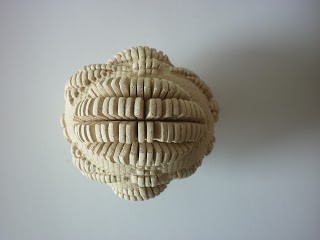
Da ich immer stark vom Material ausgehe, sehen meine Arbeiten sehr unterschiedlich aus. Sie können gegenständlich oder auch abstrakt sein. So habe ich sehr lange mit Seife gearbeitet in all ihrer Materialbeschaffenheit. Es gab auch ein Relief aus Seife, welches einen Vorhang darstellt und neben einer realen Türsituation in den Raum eingebunden ist. Auf der befindet sich Seife an den Stellen, wo die dahinterliegenden hässlichen Häuser zu sehen wären. 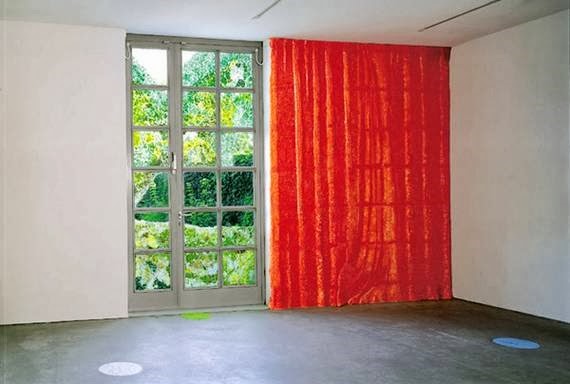
Danach habe ich lange Material wie schwarze Bau-Fugenmasse und Bausilikonfarbgemisch durch schwarze somit transparente Gaze mit Hilfe von Fingern und Spritzen gesiebt, um ein dahinterliegendes Waldmotiv durchzupausen. Es sind Reliefs daraus entstanden. Dabei wird die Vorderseite zur Rückseite. Da lag ein Konzept zugrunde. Genaueres siehe mein Blog.
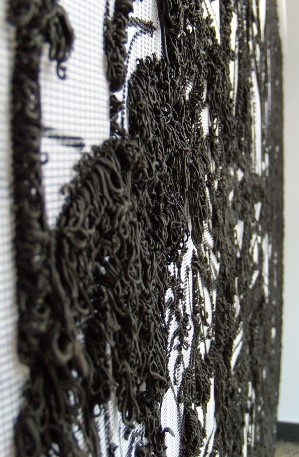
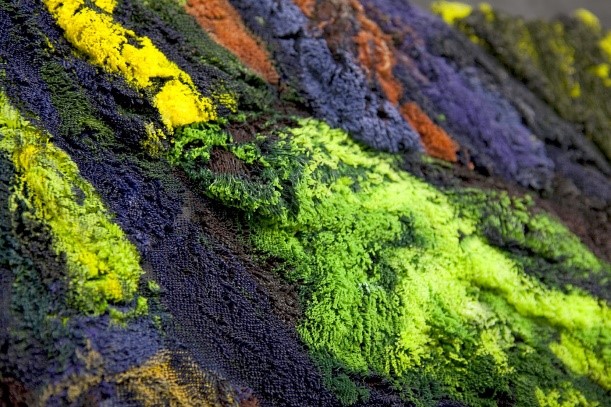
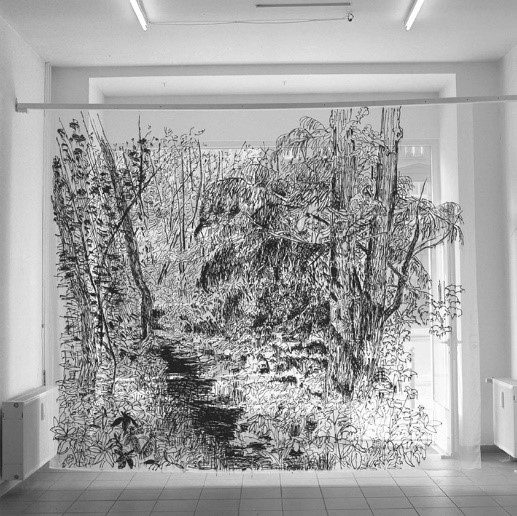
Also das Davor und Dahinter. Das ist auch Teil meiner permanenten Wasser -Licht-Projektion in Bergkamen. Es werden Brunnenmotive aus Europa durch das Wasser projiziert und man sieht das Motiv auf der anderen Seite.
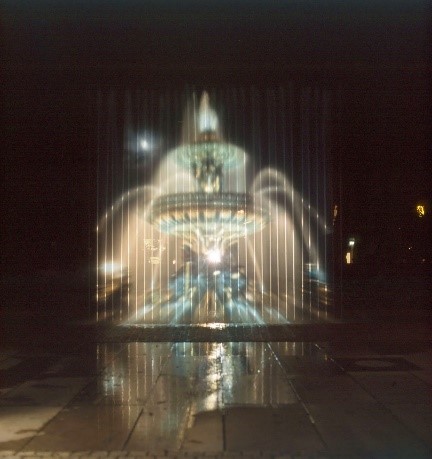
Außerdem habe ich immer gezeichnet. Es gab vorher Waldzeichnungen (auch Vorlage für die Waldstücke aus Baufugenmasse), die ich Spiegelungen nenne. Spiegelungen spielen bei den CUTS ja auch eine große Rolle.
Wie definieren Sie Ihre Kunstwerke, die Sie an die Fensterscheiben kleben. Sie nennen Sie Cuts, aber sind es eher Bilder, Objekte oder Konzepte, die Sie hier ausstellen?
Die Cuts sind Hybride, nicht eindeutig Konzept, Bild oder Objekt, von allem etwas.
Bild oder Objekt; das ist unterschiedlich. Da die CUTS sehr variieren. Meistens sind sie eher partiell auf die Scheibe geklebt, dann sind sie eher objekthaft. Manchmal wird das ganze Schaufenster mit seinen Ausmaßen mit einbezogen. Dann sind es eher Bilder.
Oft entsteht das Bild auch erst in der Abbildung des CUTS mit seinen Spiegelungen als Foto.
Wie gesagt, es ist eine Mischung aus Konzept und Bildern oder Bildobjekten. Man hört ja nicht auf zu denken, wenn man handelt. Der Umraum spielt eine Rolle. Es gibt eine Bündelung von Innen und Außen auf der Glasfläche. Das interessiert mich. Man sieht den realen Innenraum und den Außenraum als Spiegelung. Außerdem ändere ich oft mein Vorgehen bei der künstlerischen Handlung und das flexible daran interessiert mich. Die Farben und Strukturen der Klebestreifenreste, welche es nur in begrenzter Anzahl gibt, regen mich an und inspirieren mich zu immer weiteren abstrakten Formen.
Ich empfinde das auch nicht als Ausstellung, sondern eher ein Sichtbarmachen meiner Handlung und des leerstehenden Raumes.
Zum Konzept gehören auch die Rahmenbedingungen, die ich mir stecke. Dass ich fast ausschließlich auf leerstehende Ladenlokale klebe und keinen Namen hinterlasse. Das ich im Außenraum arbeite und nicht artifiziell nur im Kunstkontext, das gefällt mir gut. Und die Arbeiten sind temporär.
Warum nennen Sie sie Cuts?
Das ist simpel. Ich nenne sie Cuts, da sie erstens geschnittene Reste sind und weil sie oft aussehen wie in die Scheibe geschnitten oder zerborstene Fensterscheiben. Vor allen Dingen die Kreisformen erinnern daran.
Wie sind sie auf die Idee gekommen, in der ganzen Stadt Fensterscheiben zu nutzten. Was war der Auslöser?
Ich wollte in den Raum gehen mit meinen Zeichnungen. Aber ich wollte mir auch treu bleiben mit meiner Zweidimensionalität. Da boten sich Fensterfronten an, wo sich der Umraum bündelt. Und ich wollte nicht im Atelier, sondern draußen arbeiten. Sozusagen als urbane Entsprechung zu meinen eher klassischen Waldzeichnungen im Freien, aber mit urbanem Material. Und als ich einen leerstehenden Eckladen bei mir im Kiez gesehen habe mit Spiegeln im Schaufenster, wo man die Klebestreifen auch von der Rückseite nur weiß sehen konnte, konnte ich nicht widerstehen.
Welche Materialien benutzen Sie und woher kommen sie?
Ich benutze Klebestreifenreste von einer Druckerei. Sticker werden aus Kostengründen auf ein Blatt gedruckt und dann beschnitten. Die Klebestreifen sind also Müll. Sie kosten mich nichts, nur die Zeit, die ich benötige. Sie werden nicht extra für die Kunst hergestellt. Auf die Idee kam ich durch meine Tochter, die Sticker für Alben gesammelt hat. Ich fand die Ränder viel schöner und habe sie erst mal behalten ohne zu wissen, was ich damit machen kann. Als ich dann in eine Druckerei in Berlin kam, sah ich die Schnittreste. Da hatte ich dann die Idee.
Wie entsteht ein Kunstwerk? Wie gehen Sie vor, wenn Sie ein neues Cut erarbeiten?
Wenn ich durch Berlin fahre, halte ich Ausschau nach neuen leerstehenden Ladenflächen. Ich habe die Klebestreifen im Auto gelagert. Auch eine Leiter habe ich dabei.
Wenn ich einen Raum entdecke, der mich anspricht, und der gut gelegen ist, suche ich mir entsprechend des Raumes Streifen heraus. Ich achte dabei auf Farbähnlichkeiten des Umraumes, ob der Hintergrund dunkel oder hell erscheint. Dann beginne ich einfach ohne Vorskizze. Habe natürlich im Kopf, was ich schon gemacht habe. Ich klebe die Streifen einzeln vor Ort. Da die Streifen aber immer unterschiedlich sind, gibt es jeden CUT nur einmal.
Ich starte mit einer Bildidee, die ich aber immer wieder verwerfe und variiere. Das macht mir Spaß. Ich werde in Gespräche verwickelt und abgelenkt, wieder ändert sich meine Vorgehensweise. Ich reagiere intuitiv auf meine Umwelt und bin Teil dessen.
Die Gespräche sind auch ein wichtiger Bestandteil meiner Arbeiten. Oft wird mir etwas über den Raum erzählt oder ich werde gefragt, was für ein Laden hier entsteht oder die Leute erzählen, wo sie schon Cuts gesehen haben und freuen sich, mal ein Gesicht dazu zu sehen…
Wie wählen sie die Standorte aus?
Ich schaue, dass sich die CUTS nicht nur in einem Kiez befinden, sondern ich streue sie in ganz Berlin. So gibt es sie in Tempelhof, Mitte, Friedrichshain, Charlottenburg, Prenzlauer Berg, Wedding, Neukölln, Kreuzberg, Moabit. Meistens befinden sie sich in großen Einfahrtstraßen, wie Prenzlauer- und Schönhauser Allee, Leipziger Straße, Potsdamerstr., Kottbusser Damm …. am Alex, also mittendrin. Aber ich mag auch die stillen Seitenstraßen. Neukölln Böhmischer Platz mit einer tollen Atmosphäre. Irgendwie muss es funken zwischen mir und dem Raum.
Hatten sie schon Probleme mit Eigentümern oder Mietern?
Ja, Ärger hatte ich schon. Mehrmals wurde ich ertappt, denn ich arbeite tagsüber. Dann muss ich verhandeln. Mit der Hausverwaltung sprechen… Ich musste auch schon direkt CUTS entfernen. und man fragte mich, wie ich dazu komme, die Scheiben fremder Leute zu beschmieren. Am Anfang habe ich nachgefragt. Ein Immobilientyp hat gesagt, dass er seinen Chef fragen will, denn meine Arbeiten sähen interessant aus. Doch nach zwei Wochen hatte er den Chef angeblich nicht erreicht und würde sich nochmal melden. Als er das nicht tat, habe ich einfach begonnen. Nach 7 Wochen bekam ich eine böse Mail, ich solle sofort alles entfernen, sonst müsste ich die Kosten tragen… bis heute steht der Laden in der Potsdamer Straße leer und ist mit Plakaten beklebt. Meistens habe ich aber Glück und die Cuts sind eine Weile zu sehen.
Sind Sie enttäuscht, wenn manche Cuts verschwinden, wenn z.B. das Haus renoviert wird oder gar abgerissen?
Ja, manchmal bin ich schon etwas enttäuscht, wenn sie schnell entfernt werden. Ich hänge doch irgendwie an meinen Arbeiten. Aber das ist nur kurz. Wenn die CUTS längere Zeit zu sehen sind freu ich mich, bin ich aber auch froh, wenn sie wieder verschwinden und es neuen Raum zu suchen gilt. Das Temporäre gefällt mir gut, ist ja auch Teil des Konzepts. Mir bleiben ja die Fotos, denn ich dokumentiere die CUTS und archiviere damit auch den Ort Anschließend setze ich sie auf meinen Blog. http://birgithoelmer.blogspot.de/p/aktuell.html
Wenn ich jetzt durch Berlin fahre sehe ich die neuen veränderten, betriebsamen Orte oder wenn Gebäude verschwinden, wie z.B „Das Drive“ in in der Leipziger Strasse. Dann finde ich gut, dass es sie wirklich gab, die Auszeit mit den CUTS auf den Scheiben. Manchmal verschwinden aber auch Orte, wo es weh tut. Z.B. die Bar Babette in der Karl-Marx-Allee wird auch Opfer der Gentrifizierung. Sie muss im Oktober 2018 schließen, weil der Vertrag nicht mehr verlängert wird. Aber bis dahin gibt es da noch viel gute Kunst/ Kultur und alle 2 Monate einen neuen CUT an der Tür zu sehen.
Machen Sie das nur in Berlin oder auch an anderen Stadtorten?
Bisher arbeite ich hauptsächlich in Berlin, weil ich die meiste Zeit hier verbringe. Aber wenn ich eingeladen werde, klebe ich auch in anderen Städten und Ländern. Ich war gerade 4 Wochen in Gibraltar im Rahmen des Residency Exchange Gibraltar/Berlin von den Lichtenberg Studios. In Bayreuth hatte ich letztes Jahr ein Projekt. Doch ich habe Lust bekommen zu reisen, dann werde ich wohl immer meine Streifen dabeihaben.
Wie lange brauchen Sie für einen Cut?
Das ist unterschiedlich, aber in der Regel geht das doch recht schnell. 1 bis 4 Stunden ein Schaufenster, wenn es partiell ist. Bei größeren Cuts 2 Tage, manchmal jedoch eine Woche täglich ein paar Stunden, wenn ich das ganze Showcase mit allen Fenstern beklebe.
An was arbeiten sie zur Zeit?
Ich bin gerade aus Gibraltar zurückgekommen. Ich habe heute aber schon wieder Lust, einen CUT zu kleben. Im Moment verändert sich etwas. Ich reagiere auf vorgefundene Strukturen auf den Fensterscheiben wie z.B. Plakate, weiße Farbe, Folien und Klebestreifen von Innen…. siehe Gibraltar. Das möchte ich hier fortsetzen. Dann suche ich nach einer permanenten Variante, z.B. als Negativform der Streifen mit Spraylack auf Folien und ich will ein Heft oder Katalog veröffentlichen. Ich habe dafür das Recherchestipendium von Senat Berlin erhalten.
